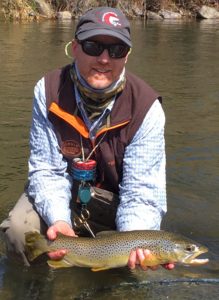 It’s May 1st, for most of you that are reading this fishing report, you know what the month of May brings, and you know what this fishing report is going to be about. Dry…Fly…Fishing! Although it is true, that the last couple of weeks have brought noses to the surface to feed on midges and the first of the baetis that have shown up so far this year; May marks the true beginning of our dry fly season here on the MO. As the water temperature rises, the amount of insect activity climbs as well, turning our underwater nymph factory into a top water buffet line for hungry pods of trout. If you have never seen 30-40 feeding trout, sometimes even more, all together in one pod working on devouring every insect that passes over them, you really should make a trip out here to the Missouri during the months of May, June, and early July. It’s a sight and experience that you’ll have a tough time forgetting.
It’s May 1st, for most of you that are reading this fishing report, you know what the month of May brings, and you know what this fishing report is going to be about. Dry…Fly…Fishing! Although it is true, that the last couple of weeks have brought noses to the surface to feed on midges and the first of the baetis that have shown up so far this year; May marks the true beginning of our dry fly season here on the MO. As the water temperature rises, the amount of insect activity climbs as well, turning our underwater nymph factory into a top water buffet line for hungry pods of trout. If you have never seen 30-40 feeding trout, sometimes even more, all together in one pod working on devouring every insect that passes over them, you really should make a trip out here to the Missouri during the months of May, June, and early July. It’s a sight and experience that you’ll have a tough time forgetting.
When you’re out on the river, really study the fish as they are eating, what you observe can help you crack the code on what exactly they are eating. Don’t be afraid to throw two dry fly patterns at the noses, or even a dry fly with a smaller emerger trailing behind. Keep in mind, the fish are eating, so if they are not eating your fly, then you probably don’t have the correct offering for them. Cycle through different dry flies and emergers until you find the right combination. Cluster Midge, Comparabuzz, CDC Parachute BWO, Corn Fed Caddis (used more for a midge cluster, there are not caddis yet), Hi-Vis Rusty Spinner, CDC Baetis Dun are all good dry fly patterns to start with. As for the emergers; Sprout Baetis Emergers, Loop Wing Emergers, RS2s, even nymphs like zebra midge and JuJu baetis patterns can be used to trail behind the dry. Just remember to tie these flies in around 6″-8″ behind that dry. The goal is to keep them around 2″-3″ below the surface. If your technique isn’t producing and you can honestly say to yourself that you have been getting a perfect dead drift, then change tactics and flies. This time of year, the fish are feeding and they are feeding well, be ready to change up.
Nymphing is still a very good technique right now on the MO, and with the current flows they way they are, be sure to throw Firebead Wire Worms and San Juans, mix in baetis nymphs as well. Pheasant Tail variations will all produce this time of year, as do Military Mays, Green Machines, Love Bugs, MFGs, Mirage Nymphs, and Zebra Midges. Winter water is becoming a thing of the past as our water temps rise and our flows continue to go up, so keep that in mind as you hit the water. Keep plugging away out there and if you have any questions, be sure to stop in and see us at either our Helena Shop or our Craig Shop. We always love talking with you and pointing you in the right direction.
